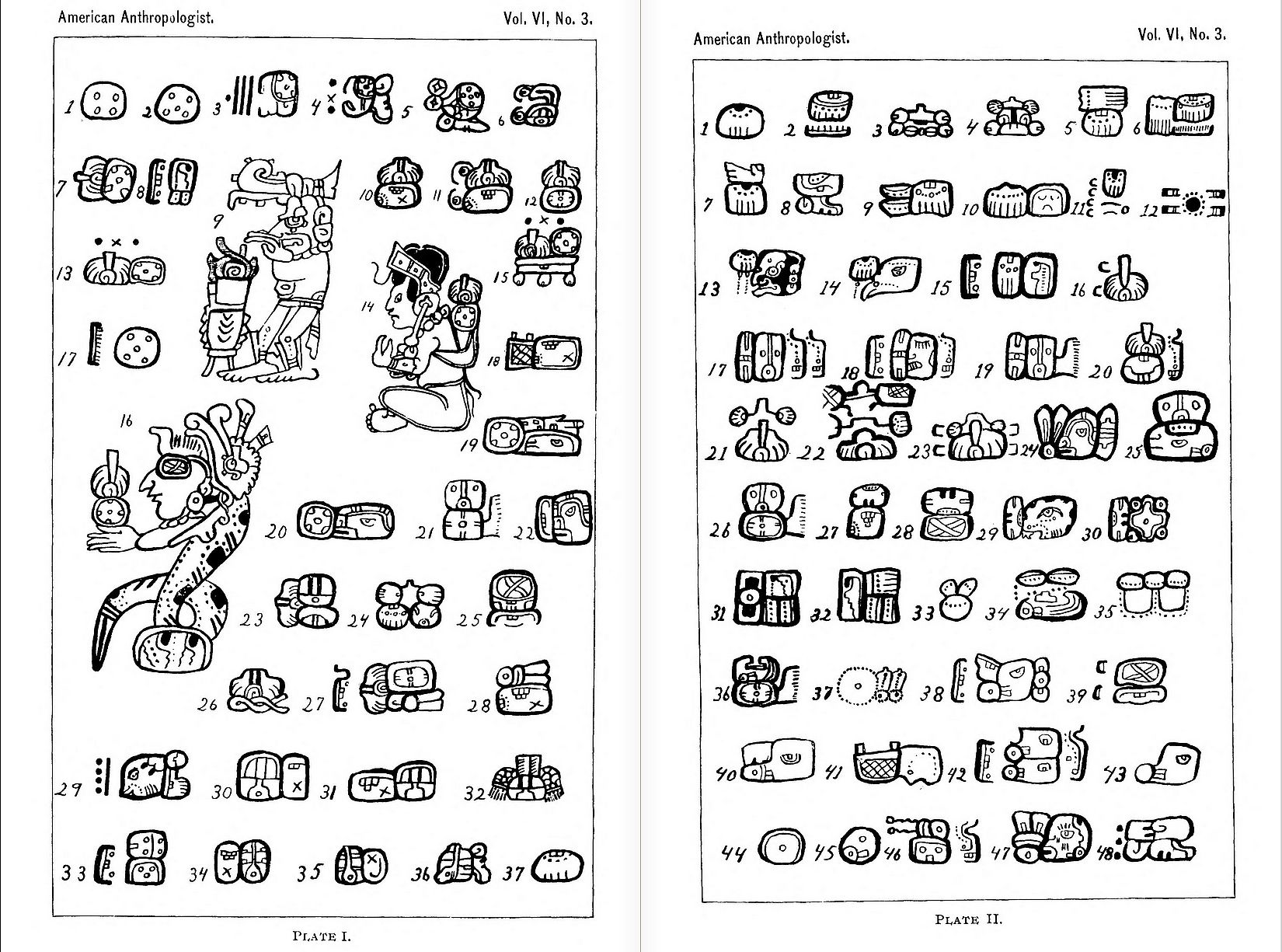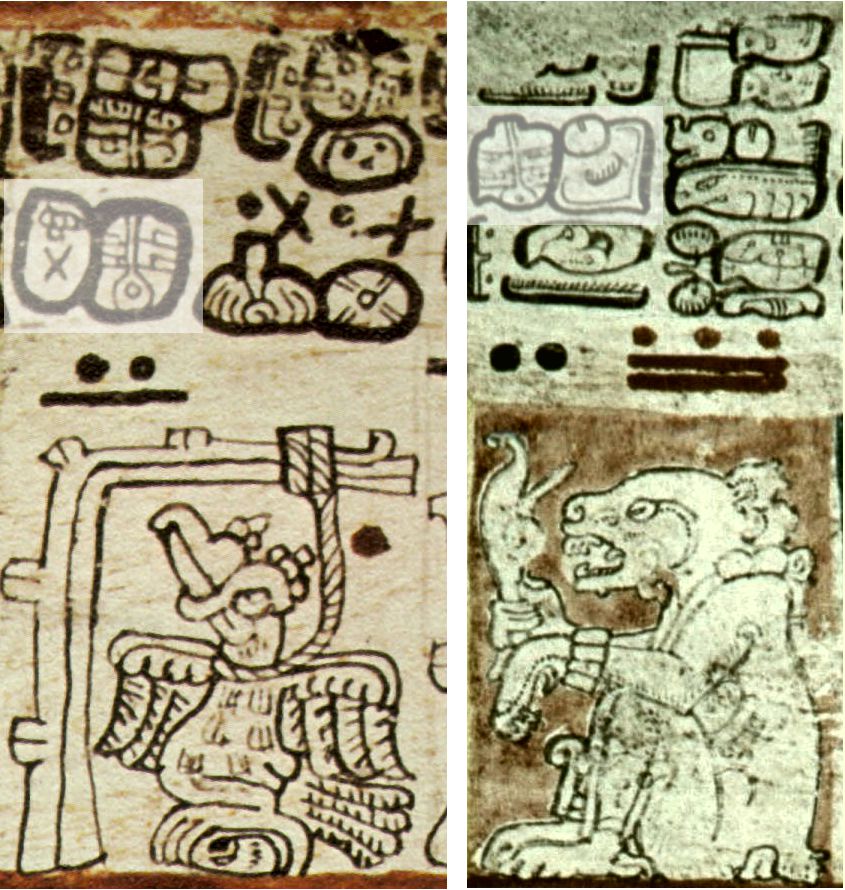und Wörterbuch
des Klassischen Maya



History of Decipherment
Background
Although phonetic decipherment of the Maya hieroglyphic writing system was initially achieved in the 1950’s, it was not until the 1980’s that this approach was widely accepted and became the established paradigm. However, the foundation for understanding the Maya script had already been laid in the 16th century when the Franciscan bishop of Yucatan, Diego de Landa, composed a written apologia, the Relación de las cosas de Yucatán, in response to legal action taken against him for having violated the rights of the Maya inhabitants.
After the conclusion of the trial, this 1566 ethnography disappeared into the archives of the Spanish colonial administration. An abbreviated copy of the original was first discovered in 1862 by the French theologian Charles Étienne Brasseur de Bourbourg. Over the course of multiple chapters, Landa addresses the calendar and also the writing system, with support from his informants Gaspar Antonio Chi and Juan Nachi Cocom, both descended from Yucatecan noble families. This represented the first revelation of the calendrical signs with their (Yucatecan) phonetic readings, and Brasseur was able to work out the bar-and-dot system of numeral notation, which had been identified by Constantine Samuel Rafinesque-Schmaltz 30 years prior.

In addition to several examples, Landa also provided an “Abc” for the Maya script that nonetheless could not be compared to any other known alphabet, as it included three signs for “A”, two for “B”, “L”, “O”, “X”, and “U”, and even some signs that were given a syllabic value, such as “CA”, “CU”, or “KU”. Because Brasseur was interpreting the signs without knowledge of the reading direction, his attempts to read individual hieroglyphic blocks in the codices were doomed to failure because of the “Abc”. Although earlier scholars like Rafinesque-Schmaltz or the American explorer John Lloyd Stephens had suspected that the script must be linked to the Mayan languages, Brasseur ignored the fact that his readings did not produce any comprehensible Mayan words. Brasseur de Bourbourg’s contribution to Maya studies instead lies in his having searched archives and private collections for numerous colonial-period dictionaries, grammars, and texts in various Mayan languages, which he then made available to the public in various publications.
Although a few isolated readings were achieved in subsequent years, like that of the cardinal directions proposed by Léon Luis de Rosny in 1876, Maya studies remained divided into two camps: those representing a phonetic approach and wanted to apply Landa’s “Abc”, and those who suspected a logographic writing system. In opposition to these stood Rosny and other researchers, like the American anthropologist Cyrus Thomas, who proposed that the Maya script was a combination of both systems – an assumption that nevertheless could not be successfully advanced. Still others, such as the American anthropologist Daniel Brinton, believed that it was a rebus writing system and compared it to the Aztec script (which, however, is itself actually phonetic as well). Léon de Rosny and Cyrus Thomas were significant masterminds behind the phonetic approach and their publications included decipherments, such as a reading of the hieroglyphic sequence ku-tzu as “turkey” (Plate II, 34-35), moo as “scarlet macaw” (Plate I, 37), kuch as “vulture” (Plate I, 34), or the logogram KAB as “earth; honey” (Plate II, 8), that were taken up by the Soviet Egyptologist Yuri Knorosov and still remain valid today.

The Calendar
Although the linguistic content of the hieroglyphic texts long remained enigmatic, rapid progress was made in the area of calendrical mathematics. After the initial work of Brasseur de Bourbourg and de Rosny, the specialist in German Studies and librarian Ernst Förstemann of Germany was the primary actor in revealing the texts’ calendrical-astronomical contents. As the curator of the Dresden Codex, he published a facsimile edition of the codex in 1882 and, by 1893, had explained the following mechanisms: the linear count of time beginning at a zero date, the structure of the 260-day almanac, the calculation of the 584-day Venus cycle, and the foundations for calculating lunar eclipses (Summary and English translation of his research).
In 1905, the American publisher John Goodman was finally able to propose a correlation of the linear count of days with the Gregorian calendar. This was confirmed by the Mexican researcher Juan Martínez Hernández in 1926, whereafter the British scholar Eric Thompson corrected the constant in 1935 by three days to 584,285 days, which links the zero point of the Maya calendar and the Julian calendar. This so-called GMT correlation is still generally recognized today.
The calendrical-astronomical school dominated Maya epigraphy through the 1950’s, a trend that incontrovertibly culminated in the 1950 publication of Thompson’s Maya Hieroglyphic Writing, which addressed in detail the majority of the known calendrical cycles. Thompson also summarized the formal aspects of the Maya script, which, together with his 1962 catalogue, have established standards valid even in the present. Nonetheless, up until just before his death in 1975, Thompson rejected the phonetic approach. Other colleagues like Floyd Lounsbury and David Kelley were more open to the new ideas of the phonetic approach, even though their work on the calendar and astronomy are their true legacies.
The Phonetic Approach
The comparative perspective of an Egyptologist was needed in order for the phonetic approach to decipherment to make a breakthrough. Between 1952 and 1955, the Soviet researcher Yuri Knorosov published multiple works on his methodology. Firstly, he established that the Maya hieroglyphic script contained approximately as many signs as that of the Egyptians, which had been deciphered in 1823 by Jean-François Champollion and contained more signs than any alphabetic script, but fewer than purely logographic systems such as Chinese. Thus, he believed that it was a mixed, logo-syllabic system.
According to Knorosov, Landa had misunderstood the syllabic signs’ CV (Consonant-Vowel) structure, based on the various signs that Landa had listed as “letters” and the few examples of CV signs (such as “CU”). Based on the 1897 work of Paul Schellhas about the representations of deities in the codices, Knorosov began to correlate the text with images and to found these correspondences on lexical information. A vignette of the Madrid Codex features the image of a turkey, called kutz in Yucatec Maya. Landa’s sign for “CU” (the colonial Spanish spelling of ku) appears in the corresponding text together with an unknown sign. Based on an assumption of vowel harmony with ku, Knorosov proposed the phonetic value tzu for the unknown sign, in this context representing the final consonant of kutz. He tested this hypothesis against a hieroglyphic block in the Dresden Codex that is associated with the image of a god, tzul in Yucatec. If the first sign is the same tzu, he deduced that the second should have the syllabic value lu. Indeed, the second sign is listed by Landa as one of the two “L” signs. Using this method, Knorosov was able to identify additional syllabic signs.

Using iconographic comparisons, Knorosov was even able to semantically isolate logograms and to approximately characterize them using Yucatec dictionaries. He thus also identified the principle of phonetic complementation, according to which syllabic signs are used as reading aids (e.g. CHAN-na for chan "sky").
Nonetheless, his methodology was not unproblematic, since not all spellings synharmonic (i.e. CV1-CV1). Rather, disharmonic (i.e. CV1-CV2) spellings were also possible. In spite of short English translations of his works that were published in American journals, Knorosov’s work long remained neglected due to real and imagined walls between East and West, and were particularly challenged by Eric Thompson.
The Historical Approach
The exiled Russian Tatiana Proskouriakoff, who was on staff at Harvard University’s Peabody Museum, pursued a different approach from that of Knorosov. In a 1960, she was able for the first time to prove that at least the inscriptions on stone monuments contained historical information on the lives of rulers. Although she rejected Knorosov’s approach, even Eric Thompson had to acknowledge that he had been incorrect in supposing that the inscriptions were only astronomical in content.
Based on a series of stelae at the site of Piedras Negras that portrayed various rulers, Proskouriakoff identified a pattern of dates with two key hieroglyphs. Based on a seriation, she was able to demonstrate that the first hieroglyph was always the earliest associated with a ruler, whereas the second was consistently some 10-30 years later, but still always after the last date given for the previous ruler. She correctly concluded that these two expressions indicated birth and accession, even though their linguistic readings were not yet known.
Proskouriakoff was able to further define the historical approach in later works with support from the work of other researchers. In this way, the German-Mexican Heinrich Berlin was able to demonstrate in 1958 that the name phrase of a ruler was always followed by a hieroglyph characterized by a fixed structure with an internal element that varied from place to place. He dubbed this the “emblem glyph” and interpreted it as the name of the corresponding city state and thus as an aid for reconstruction ancient Maya political organization.
The Fruits of a New Generation
During the time after which Knorosov’s works had become known in the West, several young students and PhD candidates were studying at Harvard University, where Proskouriakoff was also on faculty. This new generation, including David Kelley and Michael Coe, were very open to the new developments. Kelley in particular was the first to apply the phonetic approach to the monumental inscriptions and was successfully able to decipher new signs, a work which culminated in the 1976 publication of Deciphering the Maya Script and ushered in a general rethinking in the field.
A second spark for the further development of Maya epigraphy was the first Mesa Redonda in Palenque in 1973 organized by the art teacher Merle Greene Robertson, who for several years had been documenting inscriptions in the nearby ruins of the same name. For the first time, archaeologists, epigraphers, art historians, and enthusiastic laymen met and consulted together for the first time. In addition to Floyd Lounsbury, who as a mathematician and linguist made significant contributions to understanding the mythology of Palenque and had also managed to linguistically decipher Berlin’s emblem glyph two years earlier, the studio artist Linda Schele and Peter Mathews participated in the roundtable, the latter in place of his instructor David Kelley. The participants’ lasting contribution was their establishment of the dynastic history of Palenque, including the birth and death dates and names of six consecutive rulers – all in a single afternoon. Shortly thereafter, this same group was able to shed light on Palenque’s early history at a meeting in Washington, D.C.
These studies contributed new biographic information that supplemented Proskouriakoff’s two “event glyphs”, in addition to kinship expressions and much more. At the same time, human history could be incorporated into that of the gods, as demonstrated by subsequent Mesas Redondas. Still more important was the realization that texts had to be completely analyzed, representing the first steps towards understanding Classic Mayan rhetoric, syntax, and morphology. The most recent revelations in Maya epigraphy reached a broader scientific audience through the annual Maya Meetings initiated by Linda Schele in 1978.
Beginning in the late 1970’s, the decipherment of the Maya writing system made great strides. Another milestone was the 1979 conference Phoneticism in Maya Hieroglyphic Writing in Albany, which united epigraphers under the guidance of linguists. For the first time, methods from historical and comparative linguistics and graphemics were applied to the Maya script. One of the results of the conference was the first table of CV syllabic signs, which continues to be expanded upon today. Using the same methods of Knorosov, David Stuart, for instance, was able to add 10 signs and their variants to the syllabary in 1987.
Epigraphy in the Modern Era
At present, a large part of the Maya script is legible, and ongoing decipherments not only increase our understanding of the texts, but also provide us with deeper insights into Classic Maya culture. Yet while determining the phonetic value of signs remains an important task, the focus of epigraphy has expanded and developed.
An improved understanding of the script and language provides insights into language development and linguistic geography, orthographic mechanisms, and foundational cognitive processes, and thus also into phonological characteristics of the written language. As demonstrated by various works published by researchers such as Nikolai Grube, Stephen Houston, Alfonso Lacadena, John Robertson, David Stuart, or Søren Wichmann, “Classic Maya” is not a monolithic block. In particular, The Language of Classic Maya Inscriptions and Quality and Quantity in Glyphic Nouns and Adjectives from the early 2000’s, as well as the volume The Linguistics of Maya Writing, have contributed path-breaking insights and cleared the way for further research.
Over its 1500-year period of use, the Maya hieroglyphic script produced new signs, and older signs fell out of use. The written language was subjected to changes in the spoken language, which by now can be more accurately classified both temporally and genetically. For this, the dating of many inscriptions has been particularly useful. Achievements in epigraphic and linguistic study thus feed into and mutually advance each other. Yet many research questions, particularly the more detailed ones, remain problematic or unsolved, and some may never be able to be answered.
Well ahead of his time, Cyrus Thomas wrote in 1892, “Is the Maya writing phonetic? [...] This statement I firmly believe I can maintain [...].” This position can be strengthened by each result of the latest research.